NYC Studio Tour: North Brooklyn IV
In this 9th edition of the Brooklyn Studio Tour, we return to the Northside to visit the quintessential Brooklyn tracking and mixing room: Studio G . We also visit a pair of its most successful offshoots and a synth-head’s paradise near Kent Ave.
Studio G
Studio G of Williamsburg is one of the busiest, and now, one of the biggest recording studios in all of New York City. It’s also one of the most quintessentially Brooklyn studios you could ever imagine.
The original Studio G was launched in the mid-90s by Tony Maimone, who was best known then – and perhaps now – as a bassist for wildly prolific cult artists like Pere Ubu, They Might Be Giants and Frank Black.
Maimone had moved into the neighborhood in 1986, back when Williamsburg was an epicenter of the crack epidemic, and the kind of place where you could still find a New York City apartment for a few hundred bucks a month.
At the time, crime rate in the neighborhood was roughly 400% of what it is now, but Maimone’s location was good. His space was just a few blocks from the 90th precinct, and sat on a busy, central corner right across from the famous Kellog’s Diner where cops parked their cars daily for meals.
Perhaps most crucially, the studio’s door sat directly atop the step of the staircase that leads up from the G train below. Anyone who visits the area regularly has probably passed the front door of the original Studio G dozens of times without knowing it.
Maimone became a fixture of the neighborhood, and he is still one today. He’s like the mayor of every block he walks down, always finding some familiar face to wave to or smile at.
Tony is midwesterner by birth, and those smiles come easy for him. He speaks slowly, entreatingly, with a cadence like a California surfer, and he has a round, ragged face deeply lined with decades worth of wide, boyish grins.
For a half-dozen years or so, Tony Maimone made a decent go of things by himself and with a series of short-lived partners at Studio G. But the story of his studio’s rise truly begins in 1999 when a young Joel Hamilton, then in his late-twenties, came knocking on Maimone’s door looking for work.
The Rise of Studio G
It would be too easy to cast Studio G as a place that was simply built on the right spot of ground at the right time, merely riding the rising tide of a gentrifying neighborhood.
While there is certainly lot of luck that factors into the success of any space, the story of Studio G’s growth is as much the story of Joel Hamilton’s growth as anything else.
“He’s really my biggest influence as far as engineers and producers go,” Tony Maimone says of the young engineer who quickly became his partner. “Joel Hamilton is right up at the top of the heap.”
“I mean, I haven’t met a ton of engineers,” he adds, qualifying his statement, searching the room for words before beaming at me again. “I mean, I haven’t met George Martin. But I have met some top guys. He’s on that level.”
Normally, this is the part of the article where I’d add some tempering words of clear-eyed skepticism. But I have to admit that on the topic of Joel Hamilton and Studio G, I’m completely biased. I’ll even go as far as to say that Joel is easily among my own personal heroes.
Part of his success comes from taste, talent, and hard work, but part of it is because he’s consistently looked to build up communities where others have looked to build up walls.
Hamilton seems to talk to everyone he meets like he’s known them for fifteen years, and has the assertive, but genial presence of a master politician. He’s just over 40 now, with the build of a college athlete and the eyeglasses of a 1990s proto-hipster.
He speaks regularly at conferences, has done volunteer work in AIDS-ravaged South Africa, and became a fixture of the Tape Op community, writing regular reviews and actively moderating their online messageboard at the peak of its popularity. He’s also a damn good mixer.
The original Studio G, which still operates today, measures in at a bit under 1,000 square feet. Maimone, Hamilton, and an evolving cast of assistants and interns ushered it from the days of ADATs and DIGI 001s, right up to its current iteration as a climate-controlled yet thoroughly vibey space decked out with a Neve console and racks full of esoteric and boutique audio gear.
Even the acoustic treatment at the original G is spirited and unique: The control room’s diffusers are comprised of countless hundreds of vinyl records. The ones in the live room are built of salvaged scrap wood pieced together over the course of a decade. Up above, glass bricks line the south side of the building near the ceiling, allowing natural daylight to stream into the space while maintaining complete privacy and sound isolation.
Studio G 5000
As the G became busy enough to warrant an expansion, Maimone and Hamilton set their sights on a new space just North of McCarren park, a few doors down from Nicolas Vernhes’ studio, The Rare Book Room.
The New Studio G is 5,000 square feet in total, with three ample, high-ceilinged production rooms. The flagship A room is home to an SSL G Series console and some of the choicest pieces of kit from the original G.
And as the space has grown, so has the crew: An in-house tech and a “small army of interns” have joined in at the new space, and a few new engineers, Jeff Hill, Hector Castillo and John White have been helping to keep all the extra rooms busy.
In addition to a museum-worthy collection of vintage mics and a wall of rack gear that would suit three studios its size, the A room comes equipped with a Bosendorfer grand piano. Taken by itself, an instrument like that could be reason enough to book the space.
But what the owners of Studio G know better than most is that the studio world does not operate on an “if you build it, they will come” basis. Decades worth of work and career development went into warrant building a studio like this one. If Maimone and Hamilton keep up their pace, it’s easy to imagine that the new G could have an even longer run than the original. I’d bet money on that, and clearly, so would the studio’s owners.
To that point, there’s plenty of forward-looking infrastructure built into the new G. A rooftop covered in state-of-the-art solar panels promises to push the studio’s electric meter back in the other direction. It should save them on day-to-day expenses, but it’s the kind of investment – much like a grand build-out and an SSL console – that could take more than a decade to pay off.
I’m fairly certain they’ll get that chance.
The Bunker
Tony Maimone and Joel Hamilton have gone through a significant number of interns, assistants and protégés over the years. One of them, John Davis, has gone on to help create what’s probably the second-biggest new studio in North Brooklyn.
His Bunker Studio measures in at an impressive 3,000 square feet, with vaulted ceilings designed by Rod Gervais. At first glance, it’s reminiscent of Avatar’s iconic flagship tracking room across the East River. But the sound of the space is all its own: full-bodied and well-controlled with alternating stripes of wood paneling and absorptive material.
The appeal of this cavernous live room extends beyond its neighborhood, and is easily among the most expansive and most flexible in the city. The main space can fit dozens of players if it needs to, and two glass-doored isolation booths alone stand larger than the ones at many of Brooklyn’s mid-sized tracking rooms.
Between John Davis and partner Aaron Nevezie, the studio has been churning steadily for about a decade. The original location was set into a basement on the south side of Williamsburg, right across the hall from the original Strange Weather Studio – which incidentally, is also run by a one-time Studio G protégé, Marc Alan Goodman.
The pair learned more than a few things watching Studio G grow, and they even own Joel Hamilton’s old Audiotronics console. But Davis and Nevezie have come to be a driving force in the Brooklyn music scene in their own right.
The Bunker 2.0 may be an ambitious new build, but it’s no fly-by-night development. Davis and Nevezie slowly and steadily outgrew their old space, only shaping The Bunker into the new, world-class room it is today once it made practical and financial sense for them to do so. They keep their prices reasonable-but-sustainable and do memorable work as constantly as they upgrade their gear.
The A and B rooms at The Bunker lean on a collection of vintage Neumann, Gefell and RCA microphones, and the space comes equipped with a 1969 Steinway grand – a genuine source of pride for producer/engineer Aaron Nevezie. Add to that an extensive collection of vintage keyboards, drums and guitar amps, and it’s no wonder the studio is becoming one of the busiest in the city.
Vanity Sound
There’s one more studio I’ve been meaning to include in this series for quite some time: Vanity Sound, owned and operated by Myles Turney and Joel Arnow.
Like the owners of The Bunker and Strange Weather, Myles Turney is also an alumni of Studio G, where he interned years ago. He and partner Arnow built a decent-sized tracking room and a substantial mic collection just a few blocks from the original G, and carved out a niche working with seasoned, sometimes virtuosic players, for several years.
Earlier this year, their building was sold, and when their lease did not come up for renewal, Turney, Arnow, and their clients found themselves out on the street, with sessions scheduled and no place to go.
But luckily, there’s always a studio around the corner in Brooklyn. The pair began taking their sessions to Hugh Pool’s Excello Recording, and Oliver Straus’ Mission Sound, two of the earliest full-scale tracking rooms in the area, which stand directly across the street from one another just a couple blocks from the original Vanity Sound.
Turney says that he and Arnow originally planned to build a new, full-sized studio of their own, until they realized that this new arrangement suited them just fine.
Ultimately, the two decided they were happy to bring their big tracking dates into some of the best rooms that already exist, and focus on developing a small production suite of their own to help keep their clients’ work on-track and in-budget.
Turney has gone all-in on this new approach, and even sold off his console and moved his pair of Studer multi-tracks into Mission Sound, which has become a regular location for his full-band sessions.
“There’s so many great studios in this area, it almost doesn’t make sense to open another full-scale tracking room,” Turney tells me. “We can go to Mission or Excello to get a great recording. What people really don’t have in this area is a smaller space with some great mics that we can use for overdubs, edits or mixing. No one really needs a $1000/day room just to sit around doing vocal edits.”
For his own smaller-scale production room, Turney has finally made a leap he never thought he would: He’s picked up a Dangerous Summing Mixer and a Euphonix control, and has been thrilled with the results:
“I never ever ever thought I’d be the guy with a summing mixer and DAW controller, but after I met and got to be around Jon Kaplan and hear what he does with practically zero outboard and no console… well, that was kind of it.”
“It’s definitely a different workflow, but the first time I sat down, opened a session, and it came up just as I had left it with no time or fuss was totally mind-blowing. No more flipping back and forth from the last print to get the EQ’s set right.”
The new Vanity Sound is a streamlined setup compared to the original, but it still comes equipped with the overstuffed racks of gear Turney has put together over the years. Turney’s extensive mic collection has also made the trip to the new smaller-scale room, and it includes a pair of vintage ELAM 251s, a Neumann M49b, and one of the most complete collections of SONY microphones I’ve seen. But the available gear doesn’t end there. Turney knows that if he ever wants to track or mix on a vintage Neve, there’s at least two of them just around the corner.
Ground Control Studio
In any music scene, once-disparate communities seem to grow and cross-pollinate and combine. In elite circles, it sometimes appears that everybody knows everybody else.
But although we’ve focused today one studio and its offshoots, the truth is that Brooklyn – contrary to what some outsiders may believe – is anything but one big monoculture.
Sure, there may be more plaid here than anywhere this side of Scotland, but if there’s anything that I’ve learned from this tour of Brooklyn’s cottage industry of recording studios it’s that there are dozens of self-sustaining mini-scenes, each with their own audiences and frames of reference.
Murray Trider and John Bosch of Ground Control Studios, for instance, have carved out their own niche on the south side of Williamsburg, where Kent meets Broadway. It’s only a few blocks away from the other the studios we’ve profiled here, but over a decade of working side-by-side the two groups have yet to cross paths.
Tucked away in the basement of one of the most beautiful brownstones in their corner of the borough, Trider and Bosch have created a veritable synth-head’s paradise. It’s a clean, brick-lined space, filled with vintage analog classics from Moog, ARP and Roland. Rounding out that keyboard collection are some of the most rare and coveted iterations of the Fender Rhodes and Wurlitzer electric pianos ever made.
In the center of the space sits a Trident console and a pristine Neve sidecar, the latter of which was found at a fire sale auction, then painstakingly wired for the new space by co-owner Murray Trider. On one of the far ends of this long rectangular space, a small army of vintage guitars guards a cozy isolation booth, and on the other, a golden Buddah sits atop a honky-tonkin’ upright piano.
Recently, Trider has been working regularly with Reggie Watts, a brilliantly scattered performer, and one of the most absurdly dynamic musicians and comedians working today. Bosch splits his time between recording music and doing sound mixes for independent films from genre-bending documentarians and mumblecore luminaries.
Although Bosch comes from more of a guitar-based background while Trider is a DJ-turned-producer, the two bonded over their shared love of early krautrock records and other perennial favorites of white music nerds the world over.
It reminds me that even in a musical culture as kaleidoscopic as Brooklyn’s, there’s always something to connect over. When I ask Bosch how they met, he tells me that he was having a drink at a bar where Trider worked, and the two bonded over the tunes Trider was spinning. The band that he was playing? Pere Ubu. I’ll have to remember to tell Tony Maimone.
Please note: When you buy products through links on this page, we may earn an affiliate commission.







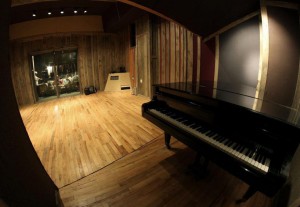
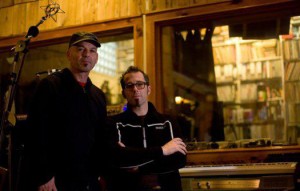
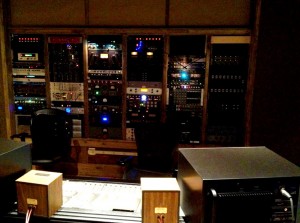
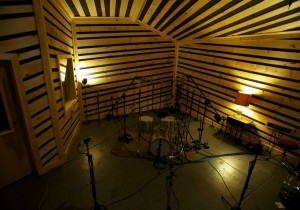
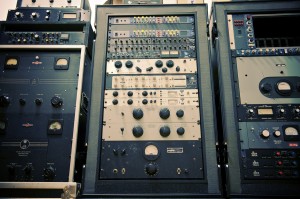
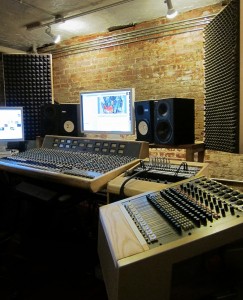
d00d
October 12, 2012 at 4:50 am (12 years ago)where rbr at?
AudioLinks
October 12, 2012 at 9:20 pm (12 years ago)Incredible facilities with some impressive pedigrees!